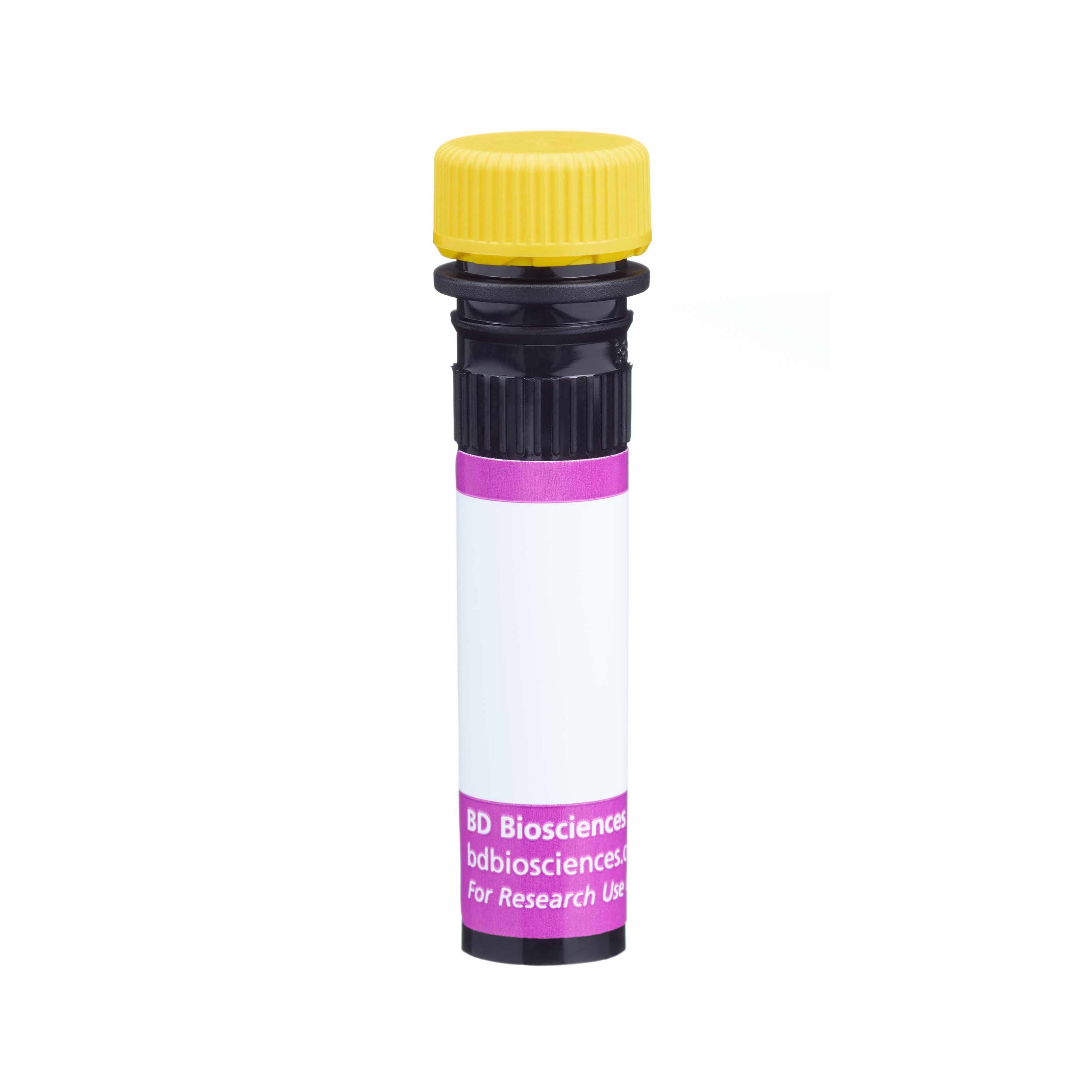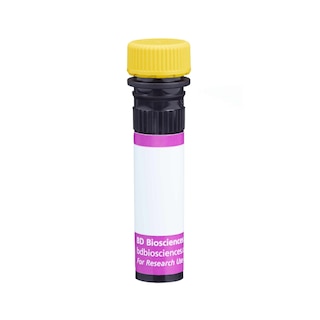-
Training
- Flow Cytometry Basic Training
-
Product-Based Training
- BD Accuri™ C6 Plus Cell Analyzer
- BD FACSAria™ Cell Sorter Cell Sorter
- BD FACSCanto™ Cell Analyzer
- BD FACSDiscover™ A8 Cell Analyzer
- BD FACSDiscover™ S8 Cell Sorter
- BD FACSDuet™ Sample Preparation System
- BD FACSLyric™ Cell Analyzer
- BD FACSMelody™ Cell Sorter
- BD FACSymphony™ Cell Analyzer
- BD LSRFortessa™ Cell Analyzer
- Advanced Training
Old Browser
This page has been recently translated and is available in French now.
Looks like you're visiting us from {countryName}.
Would you like to stay on the current location site or be switched to your location?
BD Horizon™ BV650 Hamster Anti-Mouse KLRG1
Clone 2F1 (RUO)

Multicolor flow cytometric analysis of KLRG1 expression on viable Mouse splenic leucocytes. C57BL/6 Mouse splenocytes were preincubated with Purified Rat Anti-Mouse CD16/CD32 antibody (Mouse BD Fc Block™) [Cat. No. 553141/553142]. The cells were then stained with PE Mouse Anti-Mouse NK-1.1 antibody (Cat. No. 553165/557391/561046) and with either BD Horizon™ BV650 Hamster IgG2, κ Isotype Control (Cat. No. 563860; Left Panel) or BD Horizon™ BV650 Hamster Anti-Mouse KLRG1 antibody (Cat. No. 569548; Right Panel) at 0.25 µg/test. DAPI (4',6-Diamidino-2-Phenylindole, Dihydrochloride) Solution (Cat. No. 564907) was added to cells right before analysis. The bivariate pseudocolor density plot showing the correlated expression of KLRG1 (or Ig Isotype control staining) versus NK-1.1 was derived from gated events with the forward and side light-scatter characteristics of viable (DAPI-negative) leucocytes. Flow cytometry and data analysis were performed using a BD LSRFortessa™ X-20 Cell Analyzer System and FlowJo™ software. Data shown on this Technical Data Sheet are not lot specific.

Multicolor flow cytometric analysis of KLRG1 expression on viable Mouse splenic leucocytes. C57BL/6 Mouse splenocytes were preincubated with Purified Rat Anti-Mouse CD16/CD32 antibody (Mouse BD Fc Block™) [Cat. No. 553141/553142]. The cells were then stained with PE Mouse Anti-Mouse NK-1.1 antibody (Cat. No. 553165/557391/561046) and with either BD Horizon™ BV650 Hamster IgG2, κ Isotype Control (Cat. No. 563860; Left Panel) or BD Horizon™ BV650 Hamster Anti-Mouse KLRG1 antibody (Cat. No. 569548; Right Panel) at 0.25 µg/test. DAPI (4',6-Diamidino-2-Phenylindole, Dihydrochloride) Solution (Cat. No. 564907) was added to cells right before analysis. The bivariate pseudocolor density plot showing the correlated expression of KLRG1 (or Ig Isotype control staining) versus NK-1.1 was derived from gated events with the forward and side light-scatter characteristics of viable (DAPI-negative) leucocytes. Flow cytometry and data analysis were performed using a BD LSRFortessa™ X-20 Cell Analyzer System and FlowJo™ software. Data shown on this Technical Data Sheet are not lot specific.



Multicolor flow cytometric analysis of KLRG1 expression on viable Mouse splenic leucocytes. C57BL/6 Mouse splenocytes were preincubated with Purified Rat Anti-Mouse CD16/CD32 antibody (Mouse BD Fc Block™) [Cat. No. 553141/553142]. The cells were then stained with PE Mouse Anti-Mouse NK-1.1 antibody (Cat. No. 553165/557391/561046) and with either BD Horizon™ BV650 Hamster IgG2, κ Isotype Control (Cat. No. 563860; Left Panel) or BD Horizon™ BV650 Hamster Anti-Mouse KLRG1 antibody (Cat. No. 569548; Right Panel) at 0.25 µg/test. DAPI (4',6-Diamidino-2-Phenylindole, Dihydrochloride) Solution (Cat. No. 564907) was added to cells right before analysis. The bivariate pseudocolor density plot showing the correlated expression of KLRG1 (or Ig Isotype control staining) versus NK-1.1 was derived from gated events with the forward and side light-scatter characteristics of viable (DAPI-negative) leucocytes. Flow cytometry and data analysis were performed using a BD LSRFortessa™ X-20 Cell Analyzer System and FlowJo™ software. Data shown on this Technical Data Sheet are not lot specific.
Multicolor flow cytometric analysis of KLRG1 expression on viable Mouse splenic leucocytes. C57BL/6 Mouse splenocytes were preincubated with Purified Rat Anti-Mouse CD16/CD32 antibody (Mouse BD Fc Block™) [Cat. No. 553141/553142]. The cells were then stained with PE Mouse Anti-Mouse NK-1.1 antibody (Cat. No. 553165/557391/561046) and with either BD Horizon™ BV650 Hamster IgG2, κ Isotype Control (Cat. No. 563860; Left Panel) or BD Horizon™ BV650 Hamster Anti-Mouse KLRG1 antibody (Cat. No. 569548; Right Panel) at 0.25 µg/test. DAPI (4',6-Diamidino-2-Phenylindole, Dihydrochloride) Solution (Cat. No. 564907) was added to cells right before analysis. The bivariate pseudocolor density plot showing the correlated expression of KLRG1 (or Ig Isotype control staining) versus NK-1.1 was derived from gated events with the forward and side light-scatter characteristics of viable (DAPI-negative) leucocytes. Flow cytometry and data analysis were performed using a BD LSRFortessa™ X-20 Cell Analyzer System and FlowJo™ software. Data shown on this Technical Data Sheet are not lot specific.

Multicolor flow cytometric analysis of KLRG1 expression on viable Mouse splenic leucocytes. C57BL/6 Mouse splenocytes were preincubated with Purified Rat Anti-Mouse CD16/CD32 antibody (Mouse BD Fc Block™) [Cat. No. 553141/553142]. The cells were then stained with PE Mouse Anti-Mouse NK-1.1 antibody (Cat. No. 553165/557391/561046) and with either BD Horizon™ BV650 Hamster IgG2, κ Isotype Control (Cat. No. 563860; Left Panel) or BD Horizon™ BV650 Hamster Anti-Mouse KLRG1 antibody (Cat. No. 569548; Right Panel) at 0.25 µg/test. DAPI (4',6-Diamidino-2-Phenylindole, Dihydrochloride) Solution (Cat. No. 564907) was added to cells right before analysis. The bivariate pseudocolor density plot showing the correlated expression of KLRG1 (or Ig Isotype control staining) versus NK-1.1 was derived from gated events with the forward and side light-scatter characteristics of viable (DAPI-negative) leucocytes. Flow cytometry and data analysis were performed using a BD LSRFortessa™ X-20 Cell Analyzer System and FlowJo™ software. Data shown on this Technical Data Sheet are not lot specific.

Multicolor flow cytometric analysis of KLRG1 expression on viable Mouse splenic leucocytes. C57BL/6 Mouse splenocytes were preincubated with Purified Rat Anti-Mouse CD16/CD32 antibody (Mouse BD Fc Block™) [Cat. No. 553141/553142]. The cells were then stained with PE Mouse Anti-Mouse NK-1.1 antibody (Cat. No. 553165/557391/561046) and with either BD Horizon™ BV650 Hamster IgG2, κ Isotype Control (Cat. No. 563860; Left Panel) or BD Horizon™ BV650 Hamster Anti-Mouse KLRG1 antibody (Cat. No. 569548; Right Panel) at 0.25 µg/test. DAPI (4',6-Diamidino-2-Phenylindole, Dihydrochloride) Solution (Cat. No. 564907) was added to cells right before analysis. The bivariate pseudocolor density plot showing the correlated expression of KLRG1 (or Ig Isotype control staining) versus NK-1.1 was derived from gated events with the forward and side light-scatter characteristics of viable (DAPI-negative) leucocytes. Flow cytometry and data analysis were performed using a BD LSRFortessa™ X-20 Cell Analyzer System and FlowJo™ software. Data shown on this Technical Data Sheet are not lot specific.




Regulatory Status Legend
Any use of products other than the permitted use without the express written authorization of Becton, Dickinson and Company is strictly prohibited.
Preparation And Storage
Recommended Assay Procedures
BD® CompBeads can be used as surrogates to assess fluorescence spillover (compensation). When fluorochrome conjugated antibodies are bound to BD® CompBeads, they have spectral properties very similar to cells. However, for some fluorochromes there can be small differences in spectral emissions compared to cells, resulting in spillover values that differ when compared to biological controls. It is strongly recommended that when using a reagent for the first time, users compare the spillover on cells and BD® CompBeads to ensure that BD® CompBeads are appropriate for your specific cellular application.
For optimal and reproducible results, BD Horizon Brilliant™ Stain Buffer should be used anytime BD Horizon Brilliant dyes are used in a multicolor flow cytometry panel. Fluorescent dye interactions may cause staining artifacts which may affect data interpretation. The BD Horizon Brilliant Stain Buffer was designed to minimize these interactions. When BD Horizon Brilliant Stain Buffer is used in in the multicolor panel, it should also be used in the corresponding compensation controls for all dyes to achieve the most accurate compensation. For the most accurate compensation, compensation controls created with either cells or beads should be exposed to BD Horizon Brilliant Stain Buffer for the same length of time as the corresponding multicolor panel. More information can be found in the Technical Data Sheet of the BD Horizon Brilliant Stain Buffer (Cat. No. 563794/566349) or the BD Horizon Brilliant Stain Buffer Plus (Cat. No. 566385).
Product Notices
- Please refer to www.bdbiosciences.com/us/s/resources for technical protocols.
- Caution: Sodium azide yields highly toxic hydrazoic acid under acidic conditions. Dilute azide compounds in running water before discarding to avoid accumulation of potentially explosive deposits in plumbing.
- Since applications vary, each investigator should titrate the reagent to obtain optimal results.
- For fluorochrome spectra and suitable instrument settings, please refer to our Multicolor Flow Cytometry web page at www.bdbiosciences.com/colors.
- An isotype control should be used at the same concentration as the antibody of interest.
- BD Horizon Brilliant Violet 650 is covered by one or more of the following US patents: 8,110,673; 8,158,444; 8,227,187; 8,455,613; 8,575,303; 8,354,239.
- BD Horizon Brilliant Stain Buffer is covered by one or more of the following US patents: 8,110,673; 8,158,444; 8,575,303; 8,354,239.
- Please refer to http://regdocs.bd.com to access safety data sheets (SDS).
- Alexa Fluor™ is a trademark of Life Technologies Corporation.
- For U.S. patents that may apply, see bd.com/patents.
Companion Products






The 2F1 monoclonal antibody specifically binds to KLRG1 (Killer cell Lectin-like Receptor G1), which is the mouse homolog of the rat mast cell function-associated antigen (MAFA), on all mouse strains tested (eg, AKR/J, BALB/c, C3H/HeN, C3H.SW, C57BL/6, DBA/1, SJL, 129/J). Unlike rat MAFA, which is expressed on mast cells, mouse KLRG1 is expressed on a large subset of NK cells, lymphokine-activated killer (LAK) cells, adherent LAK (A-LAK) cells, subsets of activated CD8+ T lymphocytes, and small fractions of CD4+ and CD8+ T cells, but not mast cells. The expression of KLRG1 is correlated with reduced proliferative capacity of activated T lymphocytes or reduced effector functions of activated NK cells. KLRG1 plays a role in the regulation of leucocytes of both the innate and adaptive immune system. The 2F1 mAb reportedly stains the rat basophilic leukemia cell line, RBL-2H3, which is known to express MAFA. The KLRG1 protein is an inhibitory lectin-like type II transmembrane receptor containing a cytoplasmic motif similar to ITIM (Immunoreceptor Tyrosine-based Inhibitory Motif); its ligand has not been identified KLRG1 is expressed mainly as a homodimeric molecule consisting of two N-glycosylated subunits of approximately 30-38 kDa. The level of KLRG1 expression is reduced in MHC class I-deficient mice, although direct binding of KLRG1 to MHC class I antigens could not be detected. Crosslinking of KLRG1 by 2F1 mAb reduces TCR-mediated Ca++ mobilization and cytotoxic responses (but not IFN-γ production) by CD8+ T cells and inhibits IFN-γ and TNF production and redirected lysis by NK cells.

Development References (3)
-
Beyersdorf NB, Ding X, Karp K, Hanke T. Expression of inhibitory "killer cell lectin-like receptor G1" identifies unique subpopulations of effector and memory CD8 T cells. Eur J Immunol. 2001; 31(12):3443-3452. (Clone-specific: Bioassay, Blocking, Functional assay). View Reference
-
Corral L, Hanke T, Vance RE, Cado D, Raulet DH. NK cell expression of the killer cell lectin-like receptor G1 (KLRG1), the mouse homolog of MAFA, is modulated by MHC class I molecules. Eur J Immunol. 2000; 30(3):920-930. (Immunogen: Flow cytometry, Immunoprecipitation). View Reference
-
Hanke T, Corral L, Vance RE, Raulet DH. 2F1 antigen, the mouse homolog of the rat "mast cell function-associated antigen", is a lectin-like type II transmembrane receptor expressed by natural killer cells. Eur J Immunol. 1998; 28(12):4409-4417. (Clone-specific: Flow cytometry). View Reference
Please refer to Support Documents for Quality Certificates
Global - Refer to manufacturer's instructions for use and related User Manuals and Technical data sheets before using this products as described
Comparisons, where applicable, are made against older BD Technology, manual methods or are general performance claims. Comparisons are not made against non-BD technologies, unless otherwise noted.
For Research Use Only. Not for use in diagnostic or therapeutic procedures.